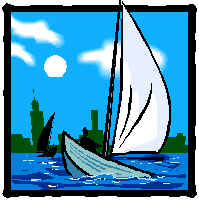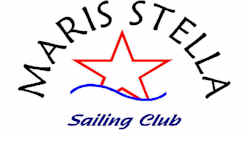|
[ The Club ] [ News From Bookshop ] [ Our Contacts ] [ Next Door Friends ] [ Ocean Sailing ] [ Paul Silver Page ] [ Doctor Fernando ] [ Charley News ] [ Muni Fashion ] [ Music on Board ] [ Events ! ] [ Cooking on Board ] [ Aid For Navigation ] [ Sail With Us ] [ Search Engines ] [ Curio's ] [ Millenium Calendar ] [ Merry Chrismas ]
Advertisement
Area
| |
 Lat 18°22'N Log 65°55'W Lat 18°22'N Log 65°55'W
Ocean Sailing and Boating by
Albert
 mail to Albert mail to Albert
News from the Oceans,
Send me your comments,
experiences, emotions we give them to all our friends.
 Albert says this Month:
Read also: Albert says this Month:
Read also:
October 1999, November
1999, December 1999,
January 2000, February 2000,
March 2000
Playing the Shifts
(by Alberto de Capitani)
Keeping up your boat speed may help you to win races but is also important when you
cruise as it adds to the pleasure of sailing efficiently. One useful technique developed
by racers is to "play the wind shifts."
Here are some basics.
First, you need to focus on the apparent wind (i.e., the wind that you feel when you
are on a moving object) rather than the true wind (i.e., the wind you feel when you are
stationary). This is because it is in the apparent wind that the boat sails.
Therefore, if you have a wind instrument, set it on the apparent wind. Otherwise, look at
your wind vane or make one by tying a telltale to the shrouds.
Be careful when trying to gauge the apparent wind from the direction of the waves, as the
waves reflect the true wind and the true wind can be quite different, in either strength
or direction, from the apparent wind.
Second, remember that the apparent wind is the result of the interaction of the
boat’s speed/direction and the true wind’s speed/direction and therefore its
direction will change whenever one of these four magnitudes changes. In particular, if you
are on a reach or a beat, the apparent wind will shift forward if the boat accelerates, if
there is a lull in true wind or if the direction of true wind shifts forward; conversely,
the apparent wind will shift aft if the boat slows, if there is a puff in true wind, or if
the direction of true wind shifts aft.
On a reach or a beat, the apparent wind will generally be stronger than the true wind, as
the boat "makes her own wind." On the other hand, if you are on a run, the
apparent wind will be less than the true wind, as the forward movement of the boat tends
to offset the velocity of the true wind. In these conditions, the direction of the
apparent wind will be the same as the true wind.
When you are on a reach or a beat and the apparent wind shifts forward (a
"header"), do not try to follow it: your sails will "pinch" and your
boat will slow down. It is better to fall off and then to head up again when the apparent
wind shifts back to its original direction (which often happens in a matter of a few
seconds). If the header lasts more than a short while (say, 30 seconds), you are better
off if you just tack.
If you are on a dead run (i.e., with the wind at 180 degrees from your course), you are
typically on your slowest point of sail. As in most boats the sails work better when the
wind flows from the luff to the leech at an apparent angle of about 80 degrees, you can
probably increase your speed by changing course to a broad reach, alternating starboard
and port tacks. If the apparent wind then shifts, play the shifts by reestablishing the 80
degree angle. If the shift lasts more than 30 seconds, consider jibing and going to the
opposite tack.
In summary, playing the shifts is a simple, useful technique that will make your sailing
faster and more efficient. Self steering devices can help to play the shifts.
A wind-powered vane (which is designed to steer the boat at a constant angle with respect
to the apparent wind) will automatically adjust the course to wind shifts, and the same
result will be obtained by an autopilot equipped with an electronic wind vane.
The limitation of these devices is that they will not tack or jibe your boat when the wind
shifts last more than a few seconds.
[ Home ] [ Up ] [ Albert News August 2000 ] [ Albert News October 2000 ] [ Albert News Dec 2000 ] [ Albert News February 2001 ] [ Albert News Oct 99 ] [ Albert News Nov99 ] [ Albert News Dic99 ] [ Albert News Jan2000 ] [ Albert News Feb 2000 ] [ Albert News March 2000 ] [ Albert News April 2000 ] [ Albert News June 2000 ]
|
 MARIS STELLA SAILING CLUB
MARIS STELLA SAILING CLUB